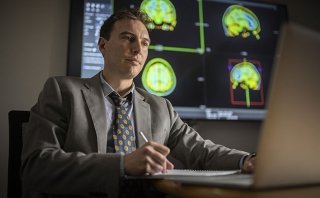Study Suggests a Strong Sense of Purpose in Life Promotes Cognitive Resilience Among Middle-Aged Adults
New research suggests that having a stronger purpose in life (PiL) may promote cognitive resilience among middle-aged adults.
-

Senior Scientist
Boston, MA - New research suggests that having a stronger purpose in life (PiL) may promote cognitive resilience among middle-aged adults. Cognitive resilience refers to the capacity of the brain to cope with stressors, injuries, and pathology, and resist the development of symptoms or disabilities. Furthermore, having a purposeful life implies changes in the organization of the brain with one specific brain network, the dorsal default mode network, showing greater functional connections within its components and with other brain areas. This may represent a neuroprotection mechanism that ultimately ensures better cognitive function into old age.
These are among the findings in the article, “Purpose in Life Promotes Resilience to Age-Related Brain Burden and Neuroprotection Through Functional Connectivity in Middle-Aged Adults,” published in the journal Alzheimer's Research & Therapy.
“The present data extend previous findings found in advanced age and pathological aging, such as Alzheimer’s disease, revealing that having a strong sense of purpose might confer resilience already in middle age,” said author Dr. Kilian Abellaneda-Pérez, from the Departament de Medicina, Facultat de Medicina i Ciències de la Salut, Institut de Neurociències, Universitat de Barcelona, Barcelona, Spain.
“The fact that individuals in the higher purpose in life group had greater connectivity between specific dorsal default- mode network nodes, which correlated with cognitive performance, suggest such changes in the functional organization of the brain may represent the mechanism by which a greater purpose in life promotes brain health and protects the brain from dysfunction even in the face of stress, adversity, and illness,” said Dr. Alvaro Pascual-Leone, medical director, The Deanna and Sidney Wolk Center for Memory Health at Hebrew SeniorLife; and Department of Neurology, Harvard Medical School. He concludes, “What is also exciting is that each of us, with appropriate guidance and support, can develop and sustain a robust sense of purpose and thus contribute to our brain health and wellbeing.”
Background
Disease-modifying agents to counteract cognitive impairment in older age remain elusive. Hence, identifying modifiable factors promoting brain reserve and resilience is paramount. In Alzheimer’s disease, education and occupation are typical reserve proxies. However, the importance of psychological factors is being increasingly recognized, as their operating biological mechanisms are elucidated. Purpose in life, one of the pillars of psychological well-being, has previously been found to reduce the deleterious effects of Alzheimer’s Disease-related pathological changes on cognition. However, whether purpose in life operates as a cognitive resilience factor in middle-aged individuals, and what are the underlying neural mechanisms, remains unknown.
Methods
Data was obtained from 624 middle-aged adults (mean age 53.71±6.9; 303 women) from the Barcelona Brain Health Initiative cohort. Individuals with lower (N=146) and higher (N=100) purpose in life (PiL) rates, according to the division of this variable into quintiles, were compared in terms of cognitive status, a measure reflecting brain burden (white matter lesions; WMLs), and resting-state functional connectivity (rs-FC), examining system segregation (SyS) parameters using 14 common brain circuits.
Results
Neuropsychological status and WMLs burden did not differ between PiL groups. However, in the lower PiL group greater WMLs entailed a negative impact on executive functions. Subjects in the higher PiL group showed lower SyS of the dorsal DMN (dDMN), indicating lesser segregation of this network from other brain circuits. Specifically, higher PiL individuals had greater inter-network connectivity between specific dDMN nodes, including the frontal cortex, the hippocampal formation, the midcingulate region, and the rest of the brain. Greater functional connectivity in some of these nodes positively correlated with cognitive performance.
Authors
Kilian Abellaneda-Pérez1,2,3, Gabriele Cattaneo3, María Cabello-Toscano1,2,3, Javier Solana3, Lídia Mulet-Pons1,2, Lídia Vaqué-Alcázar1,2, Cristina Solé-Padullés1,2, Núria Bargalló4,5, Josep M. Tormos3, Alvaro Pascual-Leone6,7, David Bartrés-Faz1,2,3
Affiliations
1Departament de Medicina, Facultat de Medicina i Ciències de la Salut, Institut de Neurociències, Universitat de Barcelona, Barcelona, Spain.
2Institut d'Investigacions Biomèdiques August Pi i Sunyer (IDIBAPS), Barcelona, Spain.
3Institut Guttmann, Institut Universitari de Neurorehabilitació adscrit a la UAB, Badalona, Spain.
4Neuroradiology Section, Radiology Department, Diagnostic Image Center, Hospital Clinic of Barcelona, University of Barcelona, Barcelona, Spain.
5Magnetic Resonance Image Core Facility (IDIBAPS), Barcelona, Spain.
6Hinda and Arthur Marcus Institute for Aging Research and Deanna and Sidney Wolk Center for Memory Health, Hebrew SeniorLife, Boston, MA, USA.
7Department of Neurology, Harvard Medical School, Boston, MA, USA.
Ethics Approval and Consent to Participate
This study was approved by the Comité d’Ètica i Investigació Clínica de la Unió Catalana d’Hospitals (ref. CEIC 17/06). All study participants provided signed informed consent.
Competing Interests
Alvaro Pascual-Leone is listed as an inventor on several issued and pending patents on the real-time integration of transcranial magnetic stimulation with electroencephalography and magnetic resonance imaging. He is co-founder of Linus Health and TI Solutions AG and serves on the scientific advisory boards for Starlab Neuroscience, Magstim Inc., Hearts Radiant, MedRhythms, TetraNeuron, and Skin2Neuron.
Funding
The research leading to these results has received funding from “la Caixa” Foundation (grant agreement n° LCF/PR/PR16/11110004). This study is also partly supported by the Spanish Ministry of Science and Innovation (RTI2018-095181-B-C2), and the National Institutes of Health (R24AG06142, and P01AG031720).
About the Hinda and Arthur Marcus Institute for Aging Research
Scientists at the Marcus Institute seek to transform the human experience of aging by conducting research that will ensure a life of health, dignity, and productivity into advanced age. The Marcus Institute carries out rigorous studies that discover the mechanisms of age-related disease and disability; lead to the prevention, treatment, and cure of disease; advance the standard of care for older people; and inform public decision-making.
About Hebrew SeniorLife
Hebrew SeniorLife, an affiliate of Harvard Medical School, is a national senior services leader uniquely dedicated to rethinking, researching, and redefining the possibilities of aging. Hebrew SeniorLife cares for more than 3,000 seniors a day across six campuses throughout Greater Boston. Locations include: Hebrew Rehabilitation Center-Boston and Hebrew Rehabilitation Center-NewBridge in Dedham; NewBridge on the Charles, Dedham; Orchard Cove, Canton; Simon C. Fireman Community, Randolph; Center Communities of Brookline, Brookline; and Jack Satter House, Revere. Founded in 1903, Hebrew SeniorLife also conducts influential research into aging at the Hinda and Arthur Marcus Institute for Aging Research, which has a portfolio of more than $63 million, making it the largest gerontological research facility in the U.S. in a clinical setting. It also trains more than 1,000 geriatric care providers each year. For more information about Hebrew SeniorLife, visit our website or follow us on our blog, Facebook, Instagram, Twitter, and LinkedIn.


